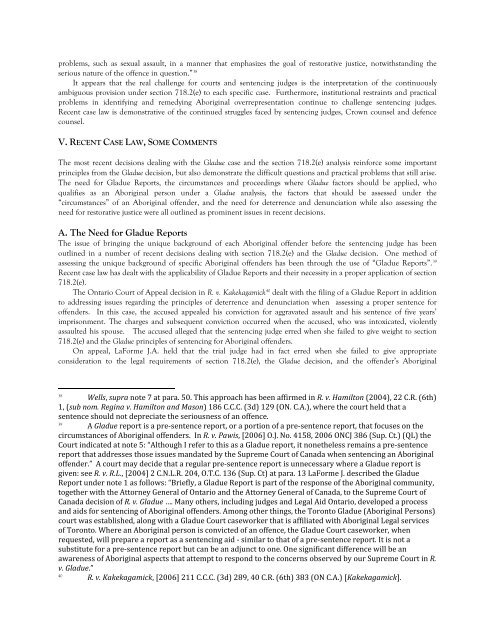Gladue Sentencing: Uneasy Answers to the Hard Problem of ...
Gladue Sentencing: Uneasy Answers to the Hard Problem of ...
Gladue Sentencing: Uneasy Answers to the Hard Problem of ...
You also want an ePaper? Increase the reach of your titles
YUMPU automatically turns print PDFs into web optimized ePapers that Google loves.
problems, such as sexual assault, in a manner that emphasizes <strong>the</strong> goal <strong>of</strong> res<strong>to</strong>rative justice, notwithstanding <strong>the</strong><br />
serious nature <strong>of</strong> <strong>the</strong> <strong>of</strong>fence in question.” 38<br />
It appears that <strong>the</strong> real challenge for courts and sentencing judges is <strong>the</strong> interpretation <strong>of</strong> <strong>the</strong> continuously<br />
ambiguous provision under section 718.2(e) <strong>to</strong> each specific case. Fur<strong>the</strong>rmore, institutional restraints and practical<br />
problems in identifying and remedying Aboriginal overrepresentation continue <strong>to</strong> challenge sentencing judges.<br />
Recent case law is demonstrative <strong>of</strong> <strong>the</strong> continued struggles faced by sentencing judges, Crown counsel and defence<br />
counsel.<br />
V. RECENT CASE LAW, SOME COMMENTS<br />
The most recent decisions dealing with <strong>the</strong> <strong>Gladue</strong> case and <strong>the</strong> section 718.2(e) analysis reinforce some important<br />
principles from <strong>the</strong> <strong>Gladue</strong> decision, but also demonstrate <strong>the</strong> difficult questions and practical problems that still arise.<br />
The need for <strong>Gladue</strong> Reports, <strong>the</strong> circumstances and proceedings where <strong>Gladue</strong> fac<strong>to</strong>rs should be applied, who<br />
qualifies as an Aboriginal person under a <strong>Gladue</strong> analysis, <strong>the</strong> fac<strong>to</strong>rs that should be assessed under <strong>the</strong><br />
“circumstances” <strong>of</strong> an Aboriginal <strong>of</strong>fender, and <strong>the</strong> need for deterrence and denunciation while also assessing <strong>the</strong><br />
need for res<strong>to</strong>rative justice were all outlined as prominent issues in recent decisions.<br />
A. The Need for <strong>Gladue</strong> Reports<br />
The issue <strong>of</strong> bringing <strong>the</strong> unique background <strong>of</strong> each Aboriginal <strong>of</strong>fender before <strong>the</strong> sentencing judge has been<br />
outlined in a number <strong>of</strong> recent decisions dealing with section 718.2(e) and <strong>the</strong> <strong>Gladue</strong> decision. One method <strong>of</strong><br />
assessing <strong>the</strong> unique background <strong>of</strong> specific Aboriginal <strong>of</strong>fenders has been through <strong>the</strong> use <strong>of</strong> “<strong>Gladue</strong> Reports”. 39<br />
Recent case law has dealt with <strong>the</strong> applicability <strong>of</strong> <strong>Gladue</strong> Reports and <strong>the</strong>ir necessity in a proper application <strong>of</strong> section<br />
718.2(e).<br />
40<br />
The Ontario Court <strong>of</strong> Appeal decision in R. v. Kakekagamick dealt with <strong>the</strong> filing <strong>of</strong> a <strong>Gladue</strong> Report in addition<br />
<strong>to</strong> addressing issues regarding <strong>the</strong> principles <strong>of</strong> deterrence and denunciation when assessing a proper sentence for<br />
<strong>of</strong>fenders. In this case, <strong>the</strong> accused appealed his conviction for aggravated assault and his sentence <strong>of</strong> five years’<br />
imprisonment. The charges and subsequent conviction occurred when <strong>the</strong> accused, who was in<strong>to</strong>xicated, violently<br />
assaulted his spouse. The accused alleged that <strong>the</strong> sentencing judge erred when she failed <strong>to</strong> give weight <strong>to</strong> section<br />
718.2(e) and <strong>the</strong> <strong>Gladue</strong> principles <strong>of</strong> sentencing for Aboriginal <strong>of</strong>fenders.<br />
On appeal, LaForme J.A. held that <strong>the</strong> trial judge had in fact erred when she failed <strong>to</strong> give appropriate<br />
consideration <strong>to</strong> <strong>the</strong> legal requirements <strong>of</strong> section 718.2(e), <strong>the</strong> <strong>Gladue</strong> decision, and <strong>the</strong> <strong>of</strong>fender’s Aboriginal<br />
38<br />
Wells, supra note 7 at para. 50. This approach has been affirmed in R. v. Hamil<strong>to</strong>n (2004), 22 C.R. (6th)<br />
1, (sub nom. Regina v. Hamil<strong>to</strong>n and Mason) 186 C.C.C. (3d) 129 (ON. C.A.), where <strong>the</strong> court held that a<br />
sentence should not depreciate <strong>the</strong> seriousness <strong>of</strong> an <strong>of</strong>fence.<br />
39<br />
A <strong>Gladue</strong> report is a pre-sentence report, or a portion <strong>of</strong> a pre-sentence report, that focuses on <strong>the</strong><br />
circumstances <strong>of</strong> Aboriginal <strong>of</strong>fenders. In R. v. Pawis, [2006] O.J. No. 4158, 2006 ONCJ 386 (Sup. Ct.) (QL) <strong>the</strong><br />
Court indicated at note 5: “Although I refer <strong>to</strong> this as a <strong>Gladue</strong> report, it none<strong>the</strong>less remains a pre-sentence<br />
report that addresses those issues mandated by <strong>the</strong> Supreme Court <strong>of</strong> Canada when sentencing an Aboriginal<br />
<strong>of</strong>fender.” A court may decide that a regular pre-sentence report is unnecessary where a <strong>Gladue</strong> report is<br />
given: see R. v. R.L., [2004] 2 C.N.L.R. 204, O.T.C. 136 (Sup. Ct) at para. 13 LaForme J. described <strong>the</strong> <strong>Gladue</strong><br />
Report under note 1 as follows: “Briefly, a <strong>Gladue</strong> Report is part <strong>of</strong> <strong>the</strong> response <strong>of</strong> <strong>the</strong> Aboriginal community,<br />
<strong>to</strong>ge<strong>the</strong>r with <strong>the</strong> At<strong>to</strong>rney General <strong>of</strong> Ontario and <strong>the</strong> At<strong>to</strong>rney General <strong>of</strong> Canada, <strong>to</strong> <strong>the</strong> Supreme Court <strong>of</strong><br />
Canada decision <strong>of</strong> R. v. <strong>Gladue</strong> …. Many o<strong>the</strong>rs, including judges and Legal Aid Ontario, developed a process<br />
and aids for sentencing <strong>of</strong> Aboriginal <strong>of</strong>fenders. Among o<strong>the</strong>r things, <strong>the</strong> Toron<strong>to</strong> <strong>Gladue</strong> (Aboriginal Persons)<br />
court was established, along with a <strong>Gladue</strong> Court caseworker that is affiliated with Aboriginal Legal services<br />
<strong>of</strong> Toron<strong>to</strong>. Where an Aboriginal person is convicted <strong>of</strong> an <strong>of</strong>fence, <strong>the</strong> <strong>Gladue</strong> Court caseworker, when<br />
requested, will prepare a report as a sentencing aid - similar <strong>to</strong> that <strong>of</strong> a pre-sentence report. It is not a<br />
substitute for a pre-sentence report but can be an adjunct <strong>to</strong> one. One significant difference will be an<br />
awareness <strong>of</strong> Aboriginal aspects that attempt <strong>to</strong> respond <strong>to</strong> <strong>the</strong> concerns observed by our Supreme Court in R.<br />
v. <strong>Gladue</strong>.”<br />
40<br />
R. v. Kakekagamick, [2006] 211 C.C.C. (3d) 289, 40 C.R. (6th) 383 (ON C.A.) [Kakekagamick].














